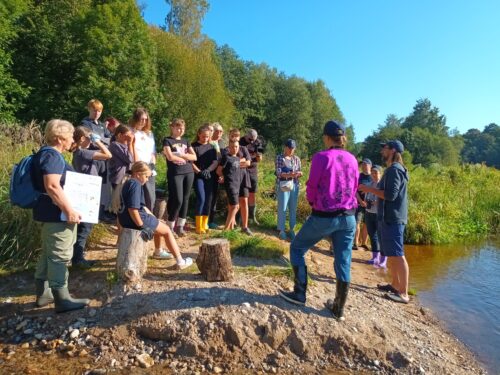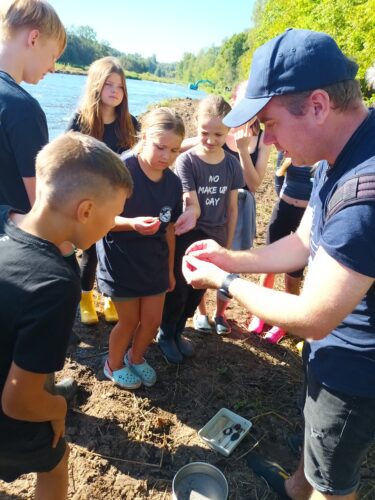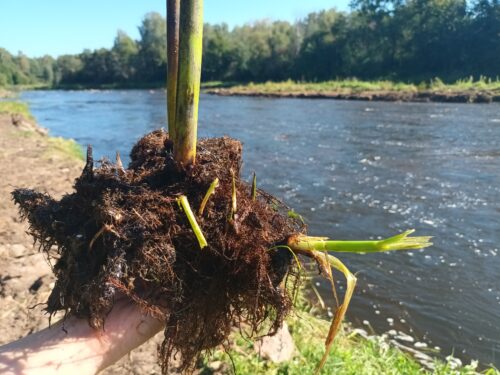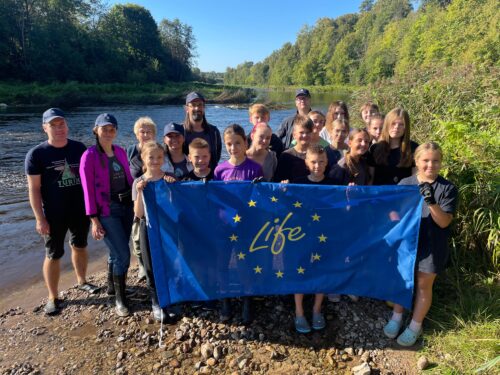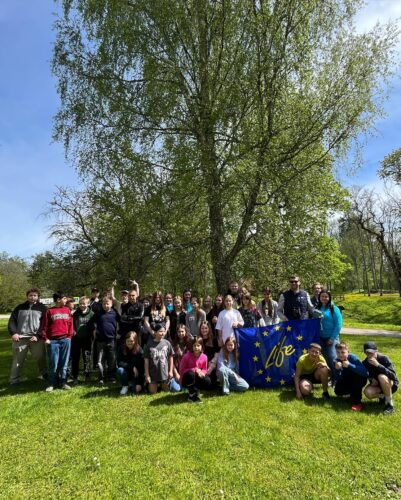To celebrate Natura 2000 Day, students of 5th and 7th grade of Mazsalaca Secondary School took part in an educational…
On Friday, 6 September, nature experts, their cooperation partners and the Young Rangers of the North Vidzeme Biosphere Reserve from the Salacgrīva Secondary School gathered in Salacgrīva municipality near the Korģe estuary. This meeting was held in the context of one of the activities of the ambitious Life is Salaca project – cleaning and restoration of the streams. This project is implemented by the State Forest Research Institute Silava, the Nature Conservation Agency (NCA), the Latvian Environment, Geology and Meteorology Centre (LVGMC), the State Scientific Institute BIOR and the Fishing Club “Salackrasti”.
Linda Uzule, a representative of NCA and the leading habitat expert of Life is Salaca, explained to the gathered young people why such a project is being implemented in the Salaca and its tributaries and why certain sections of the river are being cleaned. Unfortunately, a large part of the fast-flowing stretches of the Salaca is overgrown with surface vegetation,” said L. Uzule. One of the main culprits contributing to the high overgrowth is the lake milfoil. It causes damage by breeding very rapidly. If allowed to grow, it develops a large, thick root system at a depth of almost 30 cm, covering areas of streams. This destroys the gravelly, pebbly habitats in the river bed that are suitable for salmonid spawning and many other aquatic organisms – the Salaca needs help to retain its title as one of the main salmon rivers in Latvia and the Baltics,” said the project’s lead habitat expert, stressing the need to clear its fast-flowing sections of the compaction created by the overwater vegetation.
This summer, the “Salackrasti” practical work is taking place in the Salaca,” Ati Apelis, representative of the Board of the Association “Salackrasti”, told the rangers. It was he who told what had been done to clear the Salaca’s watercourses of overgrowth.
Using a chain excavator belonging to Salackrasti (purchased a few years ago with the support of the European Maritime and Fisheries Fund), which is especially suited for working in the rapids, to clear the river of overgrowth and restore salmonid spawning grounds, A. Apelis has already cleared a section of the Salaca near Brūveļi this summer. There, a stream channel of about four hectares has been cleared of densely overgrown lake sedge. Last Friday, the Salackrastu manager, in the presence of Life is Salaca experts and Young Rangers, worked with specialised equipment in the upper reaches of the Salaca at the mouth of the Korģe river. On that day, the NWB Young Rangers, together with Inta Soma, Head of the DAP Nature Centre North Vidzeme, gained new knowledge about the river, its inhabitants and plants, and did some good work. The young people went to work for A. Apel. When he excavated the overgrowth created by the lake with a backhoe, the young people examined the sediments and read them, and released both the large mussels and other visible living organisms back into the river. The stones were also returned to the river. Prior to this, invertebrates expert Dāvis Ozoliņš from the LVGMC told the young people about the invertebrates found in Latvia, especially those that live in the Salaca River. He explained that the most prominent of these are bivalves and also crayfish. – There are about thirty species of bivalve molluscs in Latvia, of which seven are bivalves. Five of them, such as the specially protected thick pearl mussel, can also be found in the Salaca. There are not many of them, though. That is why it is very important to get mussels back into the water when cleaning the river. They live for several decades, but overgrowth also disturbs the mussels, because the areas where they can burrow become overgrown. By cleaning the river, we can also improve the shellfish’s habitat,” said Mr Ozoliņš. He showed the young people the common water scorpion or scorpionfly, the water vole, dragonfly larvae and other invertebrates found in the Salaca. As the expert pointed out, the water scorpion and the water vole should not be in the stream. So they live in the overgrown part.
Why is the river overgrowing? This question was answered by Life is Salaca’s lead fish expert Kaspars Abersons from BIOR. The overgrowing of streams is only a consequence, the main cause is human economic activity. Household chemicals, sewage, farm fertilisers, etc. enter the river through various pathways – we unwittingly fertilise the river and it overgrows. The best way to help the river would be to stop completely the nutrients, the nutrients we produce, from flooding into the river. It is not that simple. That is why we are trying to give the river back its flow. If we do not do that, we will end up with a swamp, which is not good. It is easy to cut through the lake bed with all the stones and gravel. The hard part is to reduce the overgrowth and leave the river with a substrate suitable for salmon spawning and hiding places for their young. This is the main challenge we are working on,” said Mr Aberson.
The project representatives pointed to the misconception that salmonids like all streams equally well. This is not the case. It is important to take into account substrate, river depth and other factors to identify the reaches where restoration will give the best results. Therefore, thorough preparation took place before the chain excavator went into the river. Data was collected, cartographic material was studied, different methods were identified, experiences already implemented were identified and much discussion took place. This summer, experts have both boated the Salaca and waded the shallowest parts of the river to identify the sections where restoration of the rapids will make the most sense. L. Uzule revealed that three such stretches were planned to be restored in the Salaca this summer – the two already mentioned and a very small stretch near Atpūtai in Ainaži municipality. It has been decided to leave its cleaning for the next year of the project, when work is also planned on other sections in the vicinity. Uzule. Salackrasti is experienced – the association has been cleaning the river and restoring habitats suitable for salmonids for several years.
This is the first year of the Life is Salaca project. The ambitious project will last until 2028 and will clean up a total of 16 ha of the Salaca and 4 ha of the overgrown streams of the Jaunupe River. This summer, 6 ha of Salaca’s watercourses were cleaned. – We are doing this to improve the habitat for salmonids and the overall ecological status of the river,” said L. Uzule, pointing out that the Salackrastu chain excavator will be visible in the river for the next years of the project.
Cleaning and restoration of river courses, including the Salaca, should not be carried out beyond 15 September in order not to interfere with salmonid migration and spawning itself.
Source: Līgas Liepiņa, Limbažu novada reģionālais laikraksts “Auseklis”



